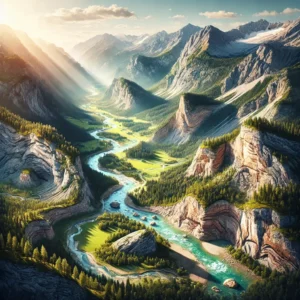Introduction
Geosphere Austria is a fascinating term that reflects the unique geological features of the country. Austria’s landscape is diverse, ranging from towering mountains to vast plains, with a rich history of geological activity that shaped the land. The Geosphere Austria encompasses everything that makes the country’s environment unique. From the Alps to the Danube River, Austria is known for its breathtaking natural beauty, rich biodiversity, and diverse ecosystems.
In this article, we will explore the various components of Geosphere Austria, focusing on its geological significance, the natural formations that define the landscape, and why understanding Austria’s geosphere is essential. This exploration will give you insight into the features that make Geosphere Austria a key aspect of the country’s environment.
What is the Geosphere?
The geosphere refers to the solid part of the Earth, which includes rocks, minerals, and landforms. It plays a crucial role in shaping the Earth’s surface and influencing the environment. In Austria, the geosphere is made up of a variety of landscapes, including mountain ranges, valleys, and plateaus. Understanding the geosphere is essential because it directly affects ecosystems, climate, and human activities.
Austria’s geosphere is a product of millions of years of geological processes, including tectonic plate movements, volcanic activity, and erosion. These processes have created the country’s current landforms, such as the Alps, which dominate the western part of Austria, and the Danube Basin, which stretches across the east.
Geological Features of Austria’s Geosphere
The Alps
The Alps are one of the most prominent features of Geosphere Austria. These mountains are part of a larger mountain system that extends across Europe. The Austrian Alps cover approximately two-thirds of the country’s total land area, making them a significant part of the geosphere. These mountains are not only a stunning natural attraction but also play a vital role in Austria’s climate, water supply, and biodiversity.
The Danube River Basin:
is a crucial part of Geosphere Austria. Flowing through Austria, the Danube River is the second-longest river in Europe. It serves as an essential water source, supporting both people and wildlife. The river’s basin provides fertile land for agriculture and is home to various ecosystems, making it an important part of Austria’s geosphere.
Caves and Underground Formations
Austria is known for its extensive network of caves and underground formations, which are also part of its geosphere. These caves have been formed by the erosion of limestone and other soft rocks over millions of years. The Eisriesenwelt, the world’s largest ice cave, is located in Austria and is a prime example of the unique geological features found within the country’s geosphere.
Importance of Geosphere Austria
Biodiversity and Ecosystems
Geosphere Austria plays a significant role in supporting the country’s biodiversity. The diverse landforms and ecosystems found across the country are a direct result of the geosphere’s geological processes. The Alps, for example, provide a habitat for numerous plant and animal species, many of which are endemic to the region. Understanding the geosphere helps scientists and environmentalists protect these ecosystems and ensure their sustainability.
Climate and Water Resources
Austria’s geosphere also has a direct impact on the country’s climate and water resources. The mountains in the western part of Austria create a barrier that affects weather patterns, leading to more precipitation in certain areas. The geosphere’s influence on the climate also plays a role in shaping Austria’s water resources. The country’s rivers and lakes are fed by precipitation that falls in the mountainous regions, providing essential water for agriculture, industry, and human consumption.
Human Activities
The geosphere influences human activities in Austria in various ways. The mountains provide opportunities for tourism, particularly for skiing and hiking. Additionally, the country’s fertile plains and river valleys support agriculture, while its underground formations are a source of minerals and raw materials. Understanding the geosphere allows Austrians to make informed decisions about land use, conservation, and development.
Challenges Facing Geosphere Austria
Climate Change
One of the biggest challenges facing Geosphere Austria is climate change. The Alps, in particular, are vulnerable to the effects of global warming. Rising temperatures are causing glaciers to melt, leading to changes in water availability and impacting the ecosystems that rely on these water sources. Additionally, climate change is affecting weather patterns, which can lead to more extreme weather events such as floods and droughts.
Land Degradation
Land degradation is another significant challenge for Geosphere Austria. Human activities, such as agriculture and urbanization, can lead to soil erosion, deforestation, and loss of biodiversity. Protecting the geosphere is essential to maintaining the natural balance of Austria’s ecosystems and ensuring the sustainability of its resources.
Mining and Resource Extraction
The extraction of minerals and other natural resources from the geosphere can have a significant impact on the environment. While these resources are essential for the economy, their extraction can lead to land degradation, pollution, and loss of biodiversity. Sustainable mining practices are crucial to protecting Austria’s geosphere and ensuring the long-term health of its environment.
Protecting Geosphere Austria
Conservation Efforts
Conservation efforts are essential to protecting Geosphere Austria. Various organizations and government agencies are working to preserve the country’s natural landscapes and ecosystems. National parks, such as the Hohe Tauern National Park, protect large areas of the geosphere and provide a habitat for numerous species. These conservation efforts help to mitigate the impacts of human activities and climate change on Austria’s geosphere.
Sustainable Land Use
Sustainable land use practices are another way to protect Geosphere Austria. This involves managing land in a way that meets human needs while preserving the natural environment. Sustainable agriculture, for example, can help to reduce soil erosion and protect biodiversity. Additionally, responsible tourism practices can help to minimize the impact of visitors on Austria’s geosphere.
Education and Awareness
Education and awareness are crucial to protecting Geosphere Austria. By understanding the importance of the geosphere and the challenges it faces, individuals and communities can take action to protect the environment. Educational programs, public campaigns, and community initiatives can all play a role in raising awareness about the need to protect Austria’s geosphere.
The Future of Geosphere Austria
The future of Geosphere Austria depends on the actions taken today to protect and preserve its natural landscapes and resources. Climate change, land degradation, and resource extraction are all significant challenges that must be addressed to ensure the long-term health of the geosphere. However, with continued conservation efforts, sustainable land use practices, and increased awareness, Austria’s geosphere can be protected for future generations to enjoy.
Innovations in Geosphere Research
Advancements in technology are allowing scientists to study the geosphere in greater detail. Innovations in satellite imaging, remote sensing, and geological mapping are providing new insights into the structure and composition of the geosphere. These advancements are helping to improve our understanding of how the geosphere functions and how it is impacted by human activities and climate change.
International Collaboration
Protecting Geosphere Austria is not just a national effort but requires international collaboration. Climate change and environmental degradation are global issues that transcend borders. By working together with other countries, Austria can contribute to global efforts to protect the environment and mitigate the impacts of climate change on the geosphere.

FAQs
What is the geosphere of Austria?
The geosphere of Austria includes the country’s landforms, rocks, minerals, and geological features. It encompasses the Alps, river basins, and underground formations.
How does the geosphere affect Austria’s biodiversity?
The geosphere provides habitats for various species and shapes the ecosystems across the country. It influences the availability of water, soil fertility, and climate, all of which impact biodiversity.
What are the major challenges facing Geosphere Austria?
The major challenges include climate change, land degradation, and resource extraction. These factors can lead to environmental damage, loss of biodiversity, and disruption of ecosystems.
How can we protect Geosphere Austria?
Protecting Geosphere Austria involves conservation efforts, sustainable land use practices, and raising awareness about the importance of the geosphere. National parks and sustainable farming practices play a key role in conservation.
Why is it important to understand the geosphere?
Understanding the geosphere is essential for managing natural resources, protecting ecosystems, and ensuring sustainable development. It helps in making informed decisions about land use and environmental protection.
Conclusion
Geosphere Austria is a critical component of the country’s natural environment. The landforms, ecosystems, and resources that make up the geosphere are essential to Austria’s biodiversity, climate, and human activities. However, the geosphere faces significant challenges, including climate change, land degradation, and resource extraction. By understanding the importance of the geosphere and taking action to protect it, we can ensure that Austria’s natural landscapes and resources are preserved for future generations.










